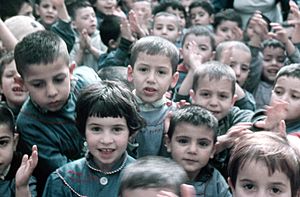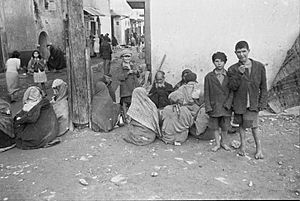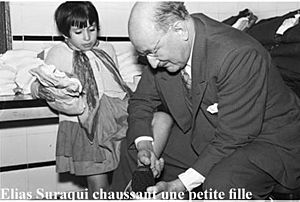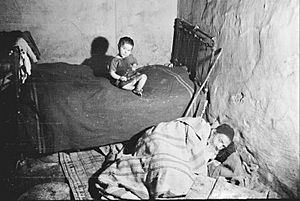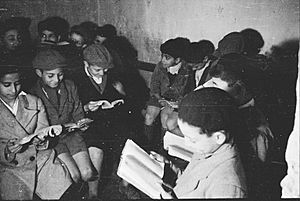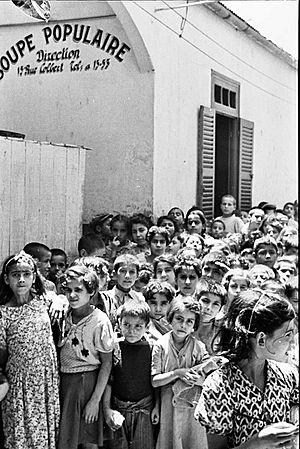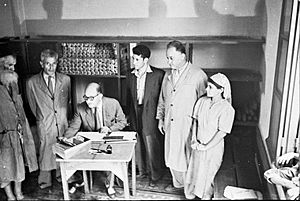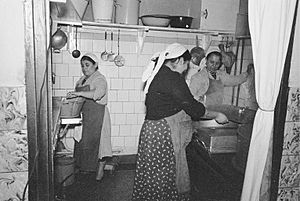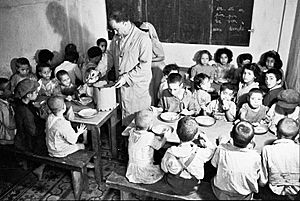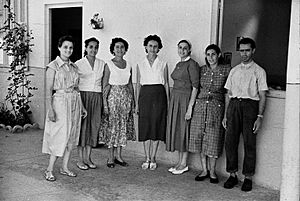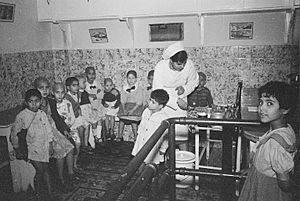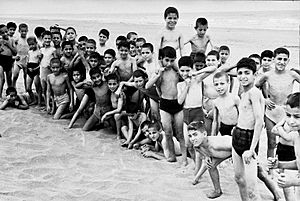Soup Kitchen (La Soupe Populaire de Casablanca) facts for kids
La Soupe Populaire pour Enfants (SP) was a special soup kitchen for children. It was located in the Mellah, which was the Jewish quarter of Casablanca, Morocco. Elias Suraqui, a local architect, started it in 1941. The SP helped children until 1964.
Starting in 1948, many groups helped fund the SP. These included the American Jewish Joint Distribution Committee (JOINT or JDC), the Alliance Israélite Universelle (AIU), and l'Œuvre de secours aux enfants (OSE). Private donors also gave money. Over the years, about 6,000 children received food and education from the SP. A team of about twelve people worked there, including teachers, cooks, and nurses.
Contents
Why the Soup Kitchen Was Needed
In 1941, the Mellah of Casablanca was very crowded. About 40,000 people lived there. Many families were very poor. They often lived in just one room. Children wore torn clothes and often had no shoes. Many children suffered from poor nutrition and sicknesses. These included skin infections, eye diseases, and lung problems.
During World War II, the French government did not help much. Even after the war, they focused on building homes for workers. Jewish organizations first helped people who survived the Holocaust. By the late 1940s, they started helping Jewish people in Morocco. Many Jewish people moved from the countryside to cities like Casablanca. This made the Mellah even more crowded.
By 1960, about 71,000 Jewish people lived in Casablanca. About 40,000 of them lived in the Mellah.
Old Study Classes: The Hedarims
Before 1941, the only places for children in the Mellah were hedarims. These were small, closed rooms with poor air. Young boys would sit close together. An adult teacher taught them the Hebrew alphabet and prayers. Hedarims were common in Jewish communities. They helped make sure Jewish men could read.
However, hedarims also helped spread diseases. By the late 1940s, groups like the JOINT worked to close them. In 1948, the JOINT planned to move 2,000 children from hedarims. They wanted to give children better care during the day. The JOINT supported new schools like Talmud Torah and the SP. These new places offered better learning and health. By the end of 1952, there were no more hedarims in the Casablanca Mellah.
History of the Soup Kitchen
Early Years: 1941–1947
The idea for the SP started in 1941. People were worried about the crowded conditions and poor health in the Mellah. Not many records exist from these early years. We do not know exactly how many children the SP helped back then.
The SP aimed to give hot meals to poor Jewish children aged 6 to 8. It also wanted to educate them. About 300 children came each year. At first, there was only one teacher and one class of thirty children. Wealthy Jewish people in Casablanca donated money. Local merchants gave food or sold it cheaply. Tailors made clothes for free from donated fabric. Bakers made bread from cheap flour.
In 1941, other Jewish groups were not ready to help all the children. But later, groups like JOINT, ORT, and AIU became more active. After Morocco became independent in 1956, many Jewish families left the Mellah.
The SP was located at 113 boulevard du 2e tirailleurs. It was a small place with two classrooms. These rooms also served as the dining area. There was also an office and a small play area. Even with some changes over the years, the SP always felt crowded.
Growth and Support: 1948–1964
After World War II, many Jewish people moved to Israel. But more people were born in the Mellah than left. Also, Jews from other parts of Morocco moved to Casablanca. This made the Mellah's population problem worse.
At first, big Jewish aid groups focused on helping Holocaust survivors in Europe. But by the early 1950s, they started helping Jewish communities in Muslim countries. The JOINT organization gave a lot of money and help to Morocco. They hired experts in health, food, and education.
The JOINT decided to focus on helping children. In 1948, they started working with the SP. They also supported other children's groups. The JOINT's help grew over the years. They supported many children's places in Casablanca, including:
| Talmud Torah | 1400 children |
| Lubavitcher | 780 children |
| Ozar Hatorah | 630 children |
| Em Habanim | 350 children |
| La Maternelle | 350 children |
| Soup Kitchen | 300 children |
| Finzi day care center (AIU) | 185 children |
How the SP Was Run
A director managed the SP. This person was chosen by the president and a committee. The director oversaw the kitchen, classrooms, and supplies. They also managed the money and ordered food. The JOINT group watched the director's work closely. They gave advice to the president, who was in charge of the SP. In the 1950s and 60s, Mr. Cohen and Mr. Teboul were directors.
In 1959, after Morocco became independent, the SP changed its rules. This was to fit the country's new laws for aid groups.
The JOINT's Big Help
From 1948, the JOINT's help was very important. They paid for almost all the food at the SP. They also gave food like milk, butter, cheese, and rice. The JOINT sent teams of doctors to check on the children. Doctors visited at least three times a year.
JOINT experts also checked how the SP was managed. They made sure the money was used well. These experts wrote reports with ideas for improvements. For example, in 1958, a report said: In the Soupe Populaire d'Enfants, many constructive changes were brought about. A new infirmary has been established... One of the classes was transformed into a dining room, which makes it possible to serve meals more efficiently.
The JOINT also gave out clothes at least once a year. In 1958, they spent a lot of money on clothes for the SP children. Photos from the 1960s show children who looked healthy and well-dressed. The number of children at the SP usually stayed between 300 and 315. In its last year, 1964, there were 210 children.
Two other Jewish groups worked closely with the JOINT to help the SP:
The Alliance Israélite Universelle (AIU)
The AIU played a key role in the SP's education. They provided the directors, teachers, and school helpers. They also created the study program. The teachers were AIU employees who worked full-time at the SP. The JOINT helped pay for this. Children learned in both French and Hebrew. Ms. Pérahia, who led another AIU center, was one of the last headmistresses at the SP.
The Organisation du Secours à l’Enfance (OSE)
The OSE was very active in Morocco. They started working with the SP in the late 1940s. With some money from the JOINT, OSE sent doctors to check all 300 children. If a child needed more help, they went to the OSE clinic in Casablanca.
The OSE also tested a special diet program at the SP. This program helped children get better nutrition. It was so successful that it was used in other Jewish centers in Morocco. OSE also gave children regular health checks and vaccinations. They even had a small room at the SP to treat sick children.
In the 1950s, OSE opened a modern clinic in Casablanca. This clinic could handle common illnesses and emergencies. For example, in 1961, 44 SP children got food poisoning. They were treated quickly at the OSE clinic.
OSE also worked hard to fight eye diseases like trachoma. In 1954, 70% of SP children had trachoma. By 1956, only 30% did. OSE also treated skin infections.
Special Programs
The Snack Program (1948)
The OSE started this program in 1948. It was first tested at the SP. Children received an extra snack. This snack included bread with jam and a healthy drink. It was given in addition to their lunch.
Better Nutrition Program (1956)
This program aimed to feed children without meat. Instead, they ate dairy, fish, and eggs. The SP was chosen to test if this diet worked. The program started in March 1956. Within six months, big improvements were seen. Doctors found that the children were healthier. They gained more weight and grew faster. They also had better blood levels and looked better. This program was later used in other children's centers.
Handling a Health Crisis
On January 11, 1961, 44 children at the SP got food poisoning. They had vomiting, stomach pain, and diarrhea. The children were quickly treated at the OSE clinic. An investigation found that the kitchen staff's health was the cause. Doctors then made sure that kitchen staff had regular health checks. They also put strict hygiene rules in place.
Giving Out Clothes
Until 1948, local groups and volunteers helped give out clothes. From 1948, the JOINT took over. They gave clothes to the children at least once a year. For example, in 1958, the 303 children at the SP received many clothes.
Summer Fun: Urban Colony
Many children in the Mellah had never left their neighborhood. They had never seen the sea or mountains. So, groups started summer camps. The JOINT helped fund these camps. In 1956, over 4,000 children went to summer camps. In 1958, over 5,000 children went.
The SP children could not go to these camps. So, a special "Urban Colony" was created for them. During the summer, classes stopped. But children still came to the SP for three meals a day. They also had outdoor activities. About 100 children at a time went to a school near the beach. This school was provided by the AIU. Children could sleep and eat there. In the mornings, they went to the beach for sports and games. In the evenings, food from the SP kitchens was brought to them.
Challenges Faced
Choosing Who to Help
One difficult problem for the SP was choosing which children to accept. For example, in 1961, there were 400 applications for only 300 spots. The JOINT social services used a point system. Children with more points were more likely to be accepted.
Limited School Access
Another challenge was what happened to children after they left the SP. In 1957-58, six SP classes could not go to AIU schools. This was because there was not enough space. The problem got worse after Morocco became independent. There were fewer European classes. Jewish children used to have good access to these. Also, schools now needed children to learn three languages: French, Hebrew, and Arabic.
Conclusion
In 1961, the founder, Elias Suraqui, moved to France. Dr. Aboudaram became the new president of the SP. The SP closed in October 1964, after 24 years of helping children. The children from the SP were moved to other Jewish centers in Casablanca. In 1967, Elias Suraqui received an award for his charity work in Morocco.
|


